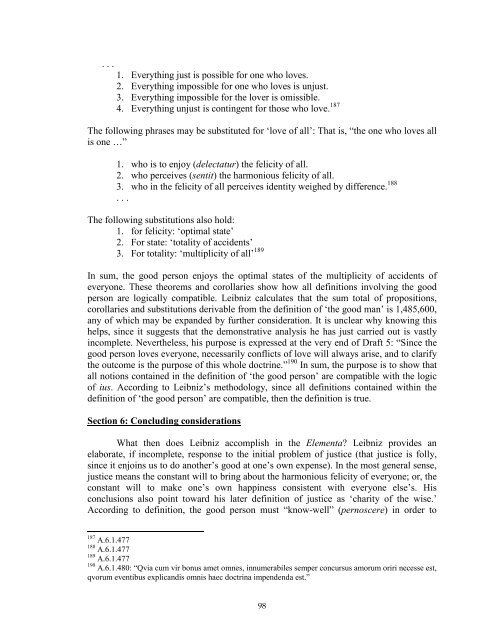Stony Brook University
Stony Brook University
Stony Brook University
Create successful ePaper yourself
Turn your PDF publications into a flip-book with our unique Google optimized e-Paper software.
. . .<br />
1. Everything just is possible for one who loves.<br />
2. Everything impossible for one who loves is unjust.<br />
3. Everything impossible for the lover is omissible.<br />
4. Everything unjust is contingent for those who love. 187<br />
The following phrases may be substituted for ‘love of all’: That is, “the one who loves all<br />
is one …”<br />
1. who is to enjoy (delectatur) the felicity of all.<br />
2. who perceives (sentit) the harmonious felicity of all.<br />
3. who in the felicity of all perceives identity weighed by difference. 188<br />
. . .<br />
The following substitutions also hold:<br />
1. for felicity: ‘optimal state’<br />
2. For state: ‘totality of accidents’<br />
3. For totality: ‘multiplicity of all’ 189<br />
In sum, the good person enjoys the optimal states of the multiplicity of accidents of<br />
everyone. These theorems and corollaries show how all definitions involving the good<br />
person are logically compatible. Leibniz calculates that the sum total of propositions,<br />
corollaries and substitutions derivable from the definition of ‘the good man’ is 1,485,600,<br />
any of which may be expanded by further consideration. It is unclear why knowing this<br />
helps, since it suggests that the demonstrative analysis he has just carried out is vastly<br />
incomplete. Nevertheless, his purpose is expressed at the very end of Draft 5: “Since the<br />
good person loves everyone, necessarily conflicts of love will always arise, and to clarify<br />
the outcome is the purpose of this whole doctrine.” 190 In sum, the purpose is to show that<br />
all notions contained in the definition of ‘the good person’ are compatible with the logic<br />
of ius. According to Leibniz’s methodology, since all definitions contained within the<br />
definition of ‘the good person’ are compatible, then the definition is true.<br />
Section 6: Concluding considerations<br />
What then does Leibniz accomplish in the Elementa? Leibniz provides an<br />
elaborate, if incomplete, response to the initial problem of justice (that justice is folly,<br />
since it enjoins us to do another’s good at one’s own expense). In the most general sense,<br />
justice means the constant will to bring about the harmonious felicity of everyone; or, the<br />
constant will to make one’s own happiness consistent with everyone else’s. His<br />
conclusions also point toward his later definition of justice as ‘charity of the wise.’<br />
According to definition, the good person must “know-well” (pernoscere) in order to<br />
187 A.6.1.477<br />
188 A.6.1.477<br />
189 A.6.1.477<br />
190 A.6.1.480: “Qvia cum vir bonus amet omnes, innumerabiles semper concursus amorum oriri necesse est,<br />
qvorum eventibus explicandis omnis haec doctrina impendenda est.”<br />
98
















